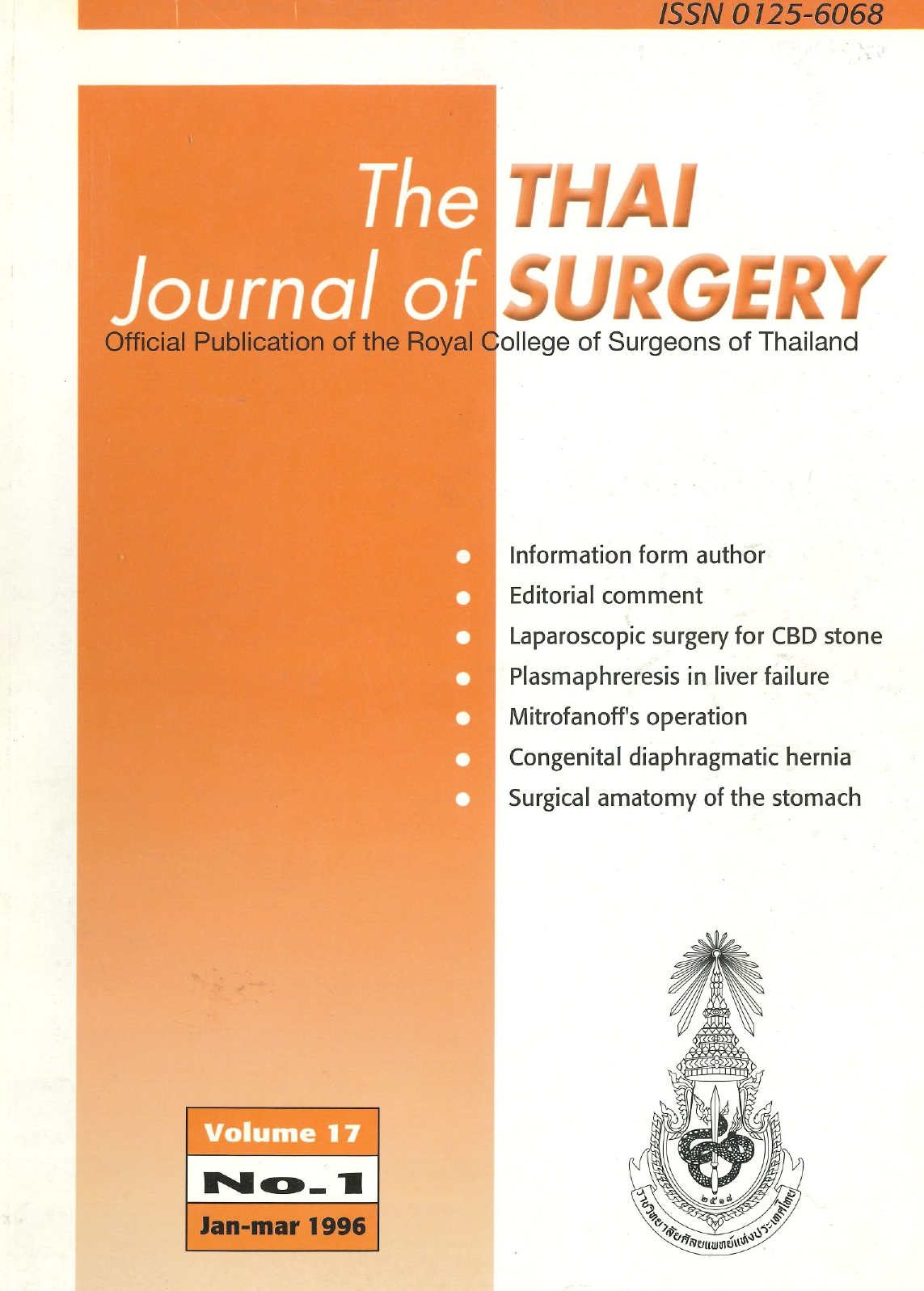Severe hepatocellular damage and acute anuric renal failure following a grade V hepatic injury treated by plasmapheresis and hemodialysis
Keywords:
Plasmapheresis, post-traumatic liver failureAbstract
A case of severe hepatocellular damage and acute anuric renal failure following a gradeV hepatic injury is presented. Renal shutdown began on the third admission day. The patient also developed progressive hyperbilirubinemia and acute liver failure. His condition deteriorated in spite of intensive supportive care and aggressive hemodialysis. Billirubin level reached 51.4 mg/dL on the 13th admission day and plasmapheresis with plasma exchange was considered necessary to decrease his bilirubin levels. Intermittent hemodialysis and plasmapheresis were undertaken until the kidneys recovered following which the hepatic function rapidly returned to normal. We conclude that although hepatic function after severe hepatic injury usually returns to normal with conventional supportive therapy and the benefit of plasmapheresis in this patient is unclear, plasmapheresis may have a role in desperate situation of liver and renal failure in which the renal failure may be further aggravated and never recover in the presence of very high bilirubin levels. Plasmapheresis reduces bilirubin levels and probably other harmful metabolites while awaiting recovery of the renal function.
References
2. Geis WP, Schulz KA, Giacchino JL. Freeark RJ. The fate of unruptured intrahepatic hematomas. Surgery 1981: 90: 689.
3. Meyer AA, Crass RA, Lim RC Jr, et al. Selective nonoperative management of blunt liver injury using computed tomography. Arch Surg 1985; 120: 550.
4. Goldstein AS, Sclafani SJA, Kufferstein NH, et al. The diagnostic superiority of computed tomography. J Trauma 1985;25: 938.
5. Lambeth W, Rubin BE. Nonoperative management of intrahepatic hemorrhage and hematoma following blunt trauma. Surg Gynecol Obstet 1979; 148: 507.
6. Yellin AE, Chaffee CB, Donovan AJ. Vascular isolation in treatment of juxtahepatic venous injuries. Arch Surg 1971: 102: 566.
7. Heaney JP, Stanton WK, Halbert DS, et al. An improved technic for vascular isolation of the liver, experimental study and case reports. Ann Surg 1966: 163: 237.
8. Pachter HL, Spencer FC. Hofstetter SR, et al. The management of juxtahepatic venous injuries without an atriocaval shunt: preliminary clinical observations. Surgery 1986: 99: 569.
9. Cox EF, Flancbaum L, Dauterive AH, et al. Blunt trauma to the liver. Analysis of management and mortality in 323 consecutive patients. Ann Surg 1988; 207: 126.
10. Bernhard WF, McMurrey JD, Curtis GW. Feasibility of partial hepatic resection under hypothermia. N Eng J Med 1955: 253: 159.
11. Delpin EA, Figueroa I, Lopez R, et al. Protective effect of steroids on liver ischemia. Am Surg 1975: 41: 683.
12. Patt A, McCroskey BL, Moore EE. Hypothermia-induced coagulopathy in trauma. Surg Clin North Am 1988: 68: 775.
13. Ferrara A, MacArthur JD, Wright HK. Hypothermia and acidosis worsen coagulopatIhy in the patient requiring massive transfusion. Am J Surg 1990; 160: 515.
14. Alper SL, Lodish HF. Disorders of the kidney and urinary tract. In Wilson JD, Braunwald E, Isselbacher KJ. Petersdorf RG. Et al (ed): Principle of Internal Medicine. 12th ed. New York. McGraw-Hill, 1991. p 1148
15. Baurn M, Stirling GA. Dawson JL. Further study into obstructive jaundice and ischaemic renal damage. Brit Med J 1969:2:229.
16. Dooley JS, Hamilton-Miller JMT, Boss M. et al. Tubular cell damage and impaired renal clearance of mezlocillin in patients with obstructive jaundice. Hepatology 1983: 3: 853A.
17. Allison ME. Moss NG, Fraser MM, et al. Renal function in chronic obstructive jaundice: a micropuncture study in rats. Clin Sci Mol Med 1987: 54: 649.
18. Heidenreich S. Brinkema E, Martin A. et al. The kidney and cardiovascular system in obstructive jaundice: functional and metabolic studies in conscious rats. Clin Sci 1987: 73: 593.
19. Lepore MJ, Martel AJ, Plasmapheresis with plasma exchange in hepatic coma: Methods and results in five patients with acute fulminant hepatic necrosis. Ann Intern Med 1970: 72:165.
20. Galbraith RA, Drummond GS, Kappas A. Suppression of bilirubin production in The Crigler-Najjar Typel Syndrome: studies with the Heme Oxygenase Inhibitor Tin-Mesoporphyrin. Pediatrics 1992: 89: 175.
21. Brenard R. Geubel AP, Benhamou JP. Benign recurrent intrahepatic cholestasis: a report of 26 cases. J Clin Gastroenterol 1989: 11: 546.
Downloads
Published
How to Cite
Issue
Section
License
Articles must be contributed solely to The Thai Journal of Surgery and when published become the property of the Royal College of Surgeons of Thailand. The Royal College of Surgeons of Thailand reserves copyright on all published materials and such materials may not be reproduced in any form without the written permission.



